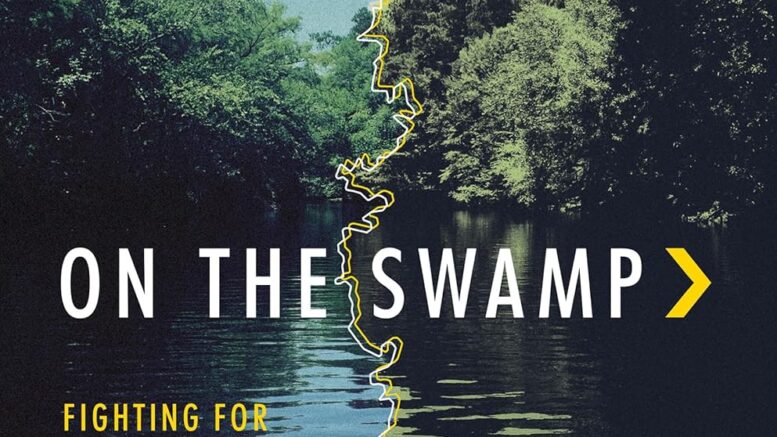Review of On the Swamp by Ryan Emanuel
By Maya L. Kapoor
As the planet grapples with the ever-starker consequences of climate change, a debut book by Lumbee citizen and Duke University scientist Ryan Emanuel makes a convincing argument that climate change isn’t the problem—it’s a symptom. The problem, Emanuel explains in On the Swamp: Fighting for Indigenous Environmental Justice, is settler colonialism and its extractive mindset, which for centuries have threatened and reshaped landscapes including Emanuel’s ancestral homeland in what today is eastern North Carolina. Real environmental solutions, Emanuel writes, require consulting with the Indigenous peoples who have both millennia of experience caring for specific places, and the foresight to avoid long-term disasters that can result from short-term material gain.
Born in Charlotte, North Carolina, in 1977, Emanuel was one of a handful of Native students at school. He spent summers visiting family in Robeson County, North Carolina, the cultural center of the Lumbee Tribe, or People of the Dark Water, where he played outside with other children, occasionally exploring a nearby swamp, one of the many lush waterways that slowly wind through the region, with a cousin. Today, Emanuel visits those swamps to conduct research. He describes them with an abiding, sometimes poetic affection, such as one spring day when he stands calf-deep in swamp water, admiring white dogwood flowers floating on the dark surface as tadpoles dart underneath.
But that affection lives with tension. Emanuel describes trying to collect “reeking” floodwater samples from a ditch after 2018’s Hurricane Florence. In Emanuel’s retelling, a nearby landowner—a white farmer who uses poultry waste as fertilizer—threatens to shoot Emanuel. The sampling, the man believes, would threaten his livelihood, which is wrapped up in North Carolina’s extractive animal farming industry— a system of giant, polluting “concentrated animal feed operations” overwhelmingly owned and operated by white people, and exposing mainly racial minorities to dirty air and water. They are a sharp contrast to the small backyard farms and truck crops grown by Emanuel’s aunties and uncles back in Robeson County a generation ago. As the man holds his gun and lectures about environmental monitoring, Emanuel reflects silently that they are standing on his ancestors’ land. Ever the researcher, he later finds deed books from around the Revolutionary War showing Emanuels once owned more than a hundred acres of land in the vicinity. Still, he holds a wry sympathy for the man, who, he notes, is worried that environmental data will jeopardize his way of life in a place his family has lived for generations.
Eastern North Carolina is a landscape of sandy fields interwoven with lush riverways and swamplands, shaded by knobby-kneed bald cypress trees and soaked with gently-moving waterways the deep brown of “richly steeped tea,” Emanuel writes. In addition to water, the region oozes history: It includes Warren County, known as the birthplace of the environmental justice movement, where local and national civil rights leaders, protesting North Carolina’s decision to dump toxic, PCB-laden soil in a new landfill in a predominantly-Black community, coined the term “environmental racism.” It’s also the mythological birthplace of English colonialism, Roanoke Island. On the Swamp draws a through line from early colonization of the continent to ongoing fights against environmental racism and for climate justice, with detailed stops along the way: Emanuel’s meticulous research illustrates how the white supremacism that settlers used to justify colonialism still harms marginalized communities—both directly, through polluting industries, and indirectly, through climate change—today.
With convoluted waterways accessible only by small boats, and hidden hillocks of high ground where people could camp and grow crops, the swamplands of eastern North Carolina protected Emanuel’s ancestors, along with many other Indigenous peoples, from genocide and enslavement by settlers. Today, with climate change alternately drying out swamplands or flooding them with polluted water from swine and poultry operations, it’s the swamps that need protection, both as a geographic place, and an idea of home. The Lumbee nation is the largest Indigenous nation in the eastern United States, but because the Lumbee Tribe gained only limited federal recognition during the 1950s Termination Era, its sovereignty is still challenged by the federal government and other Indigenous nations. Today, federal and state governments have no legal obligation to consult with the Lumbee Tribe when permitting industry or development, although the federal government does with Indigenous nations that have full federal recognition, and many industrial projects get built in Robeson County.
In writing that’s both affectionate and candid, On the Swamp is a warning about, and a celebration of, eastern North Carolina. Though the region seems besieged by environmental threats, Indigenous nations including the Lumbee are fighting for anticolonial climate justice.
Maya L. Kapoor is an award-winning science journalist who covers climate change, biodiversity, and environmental justice.
Source: grist.org, May 17, 2024

